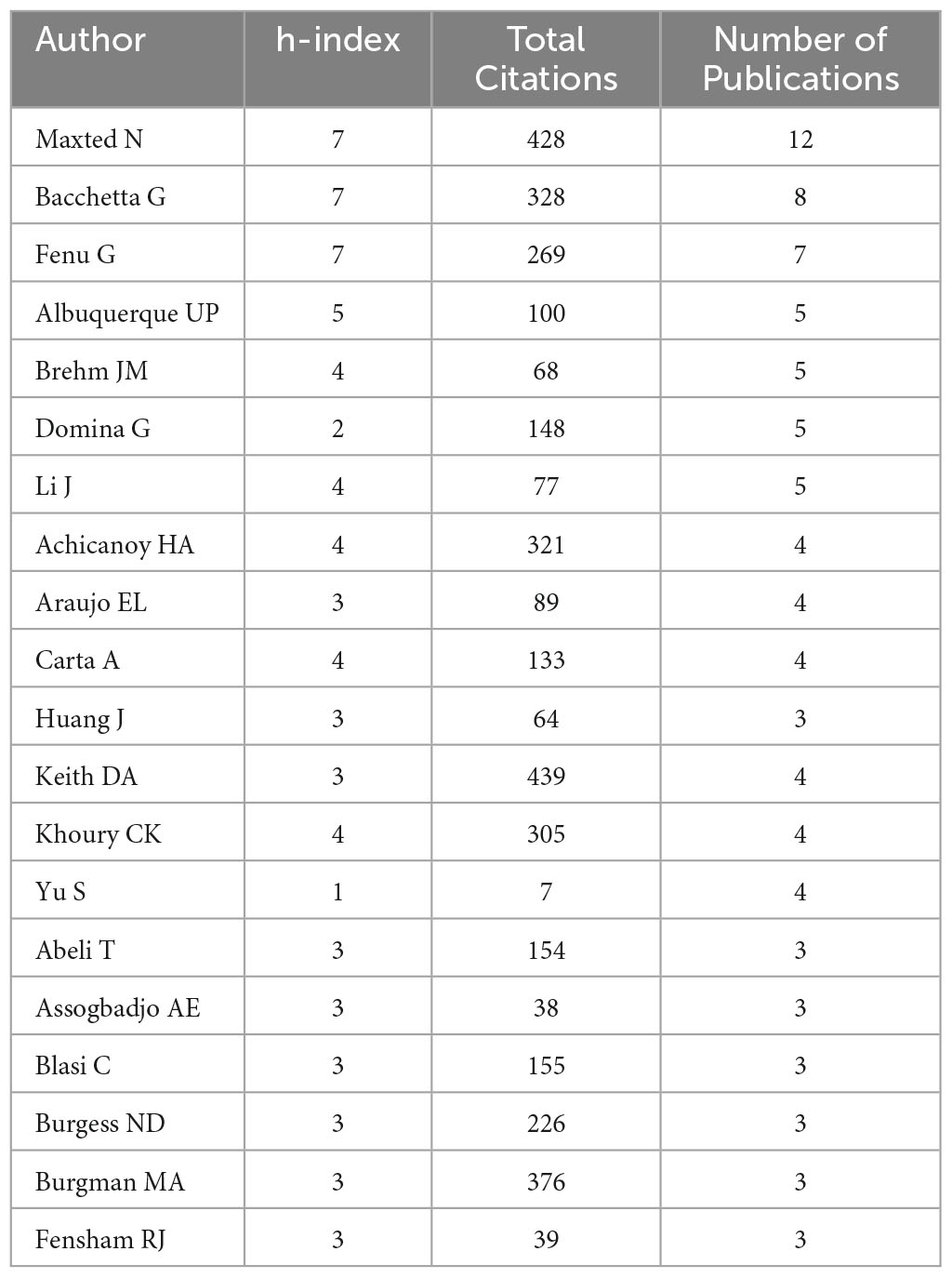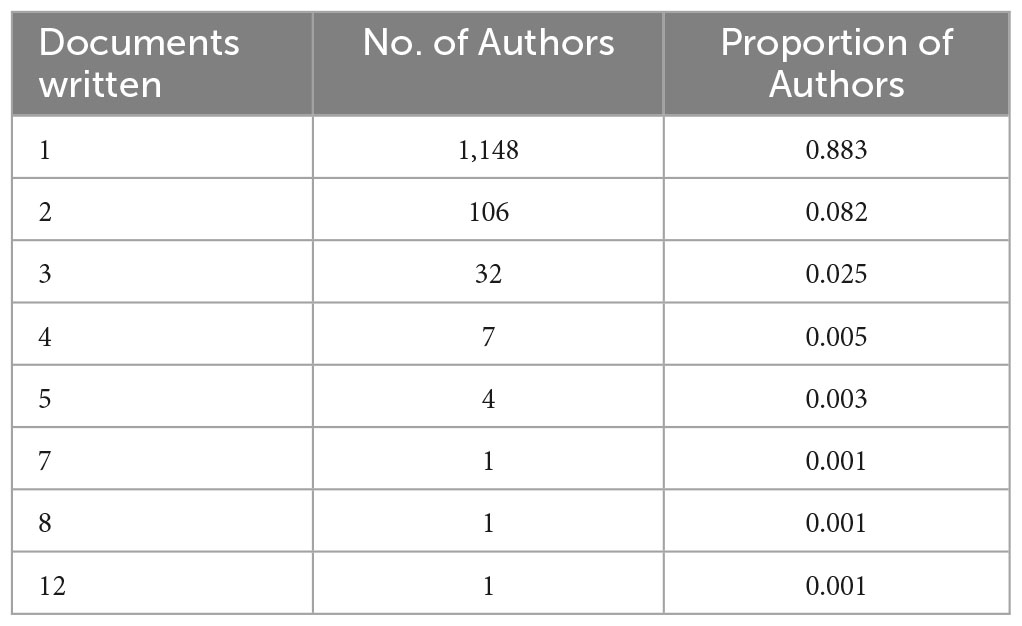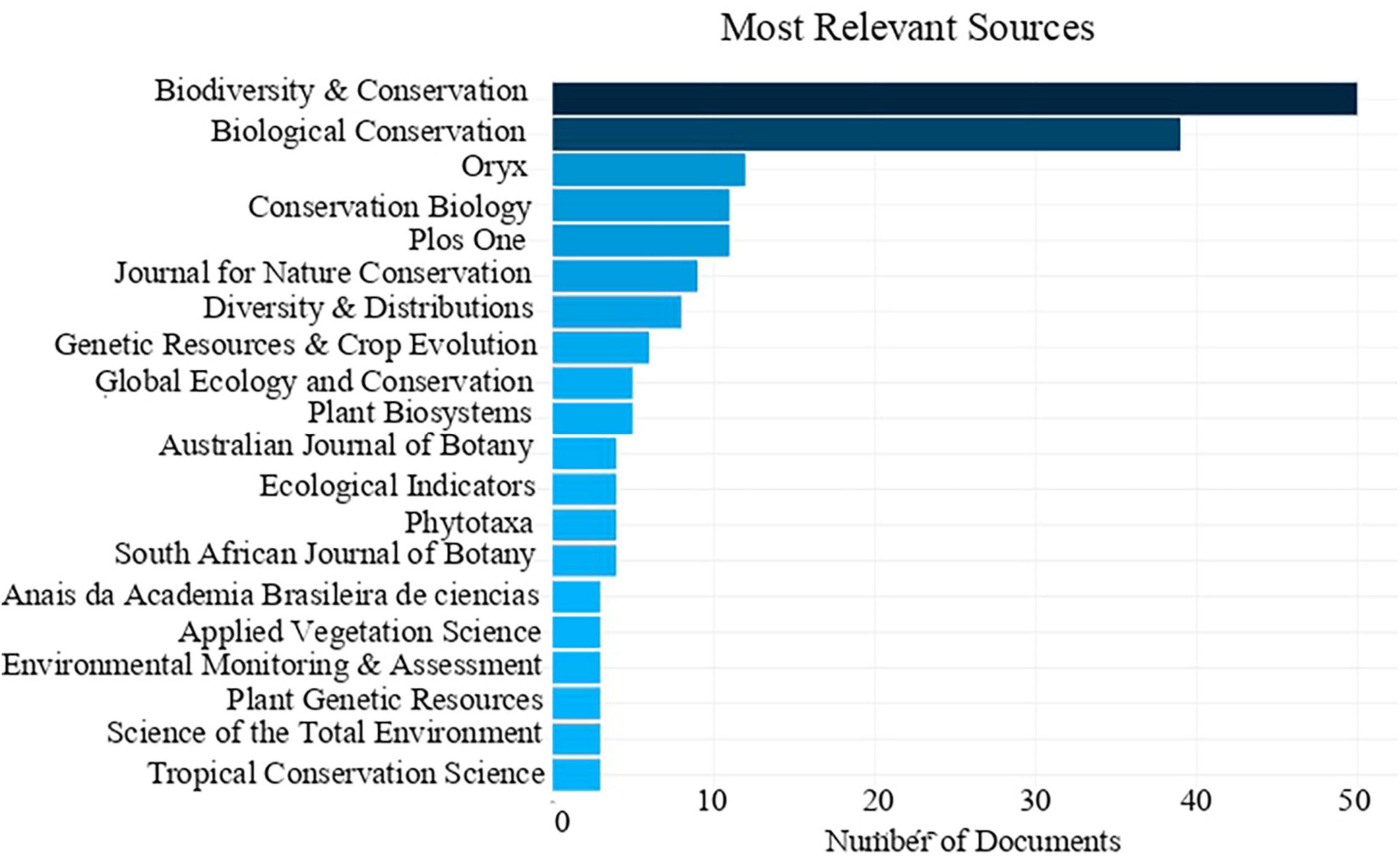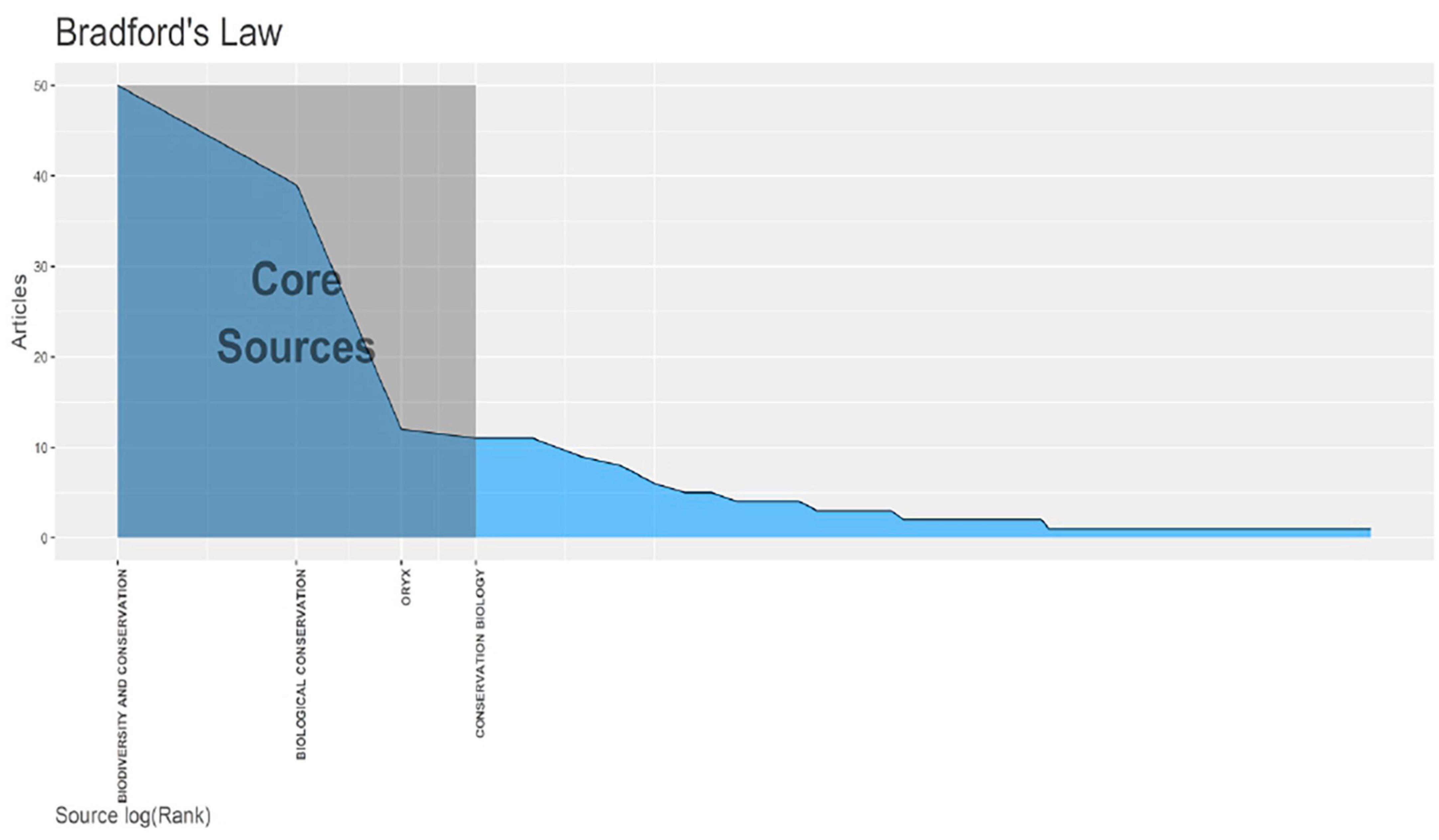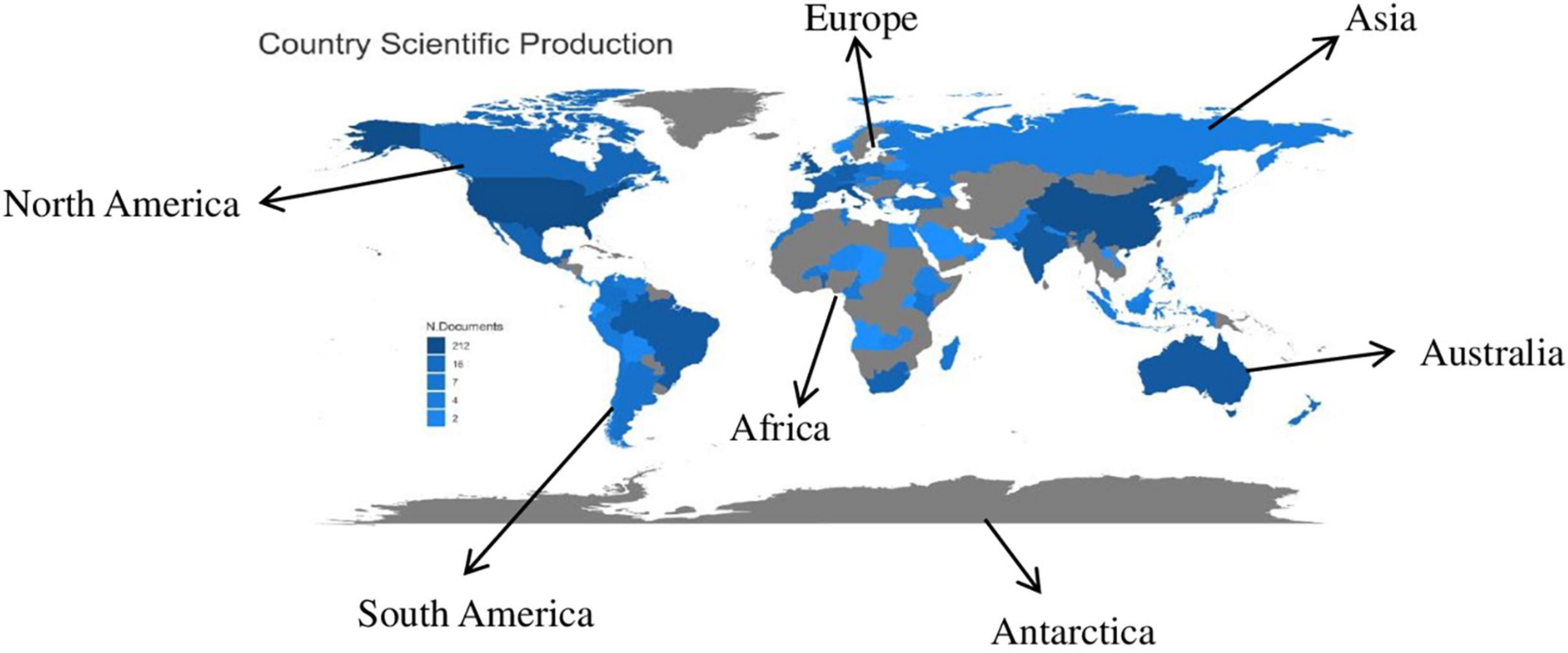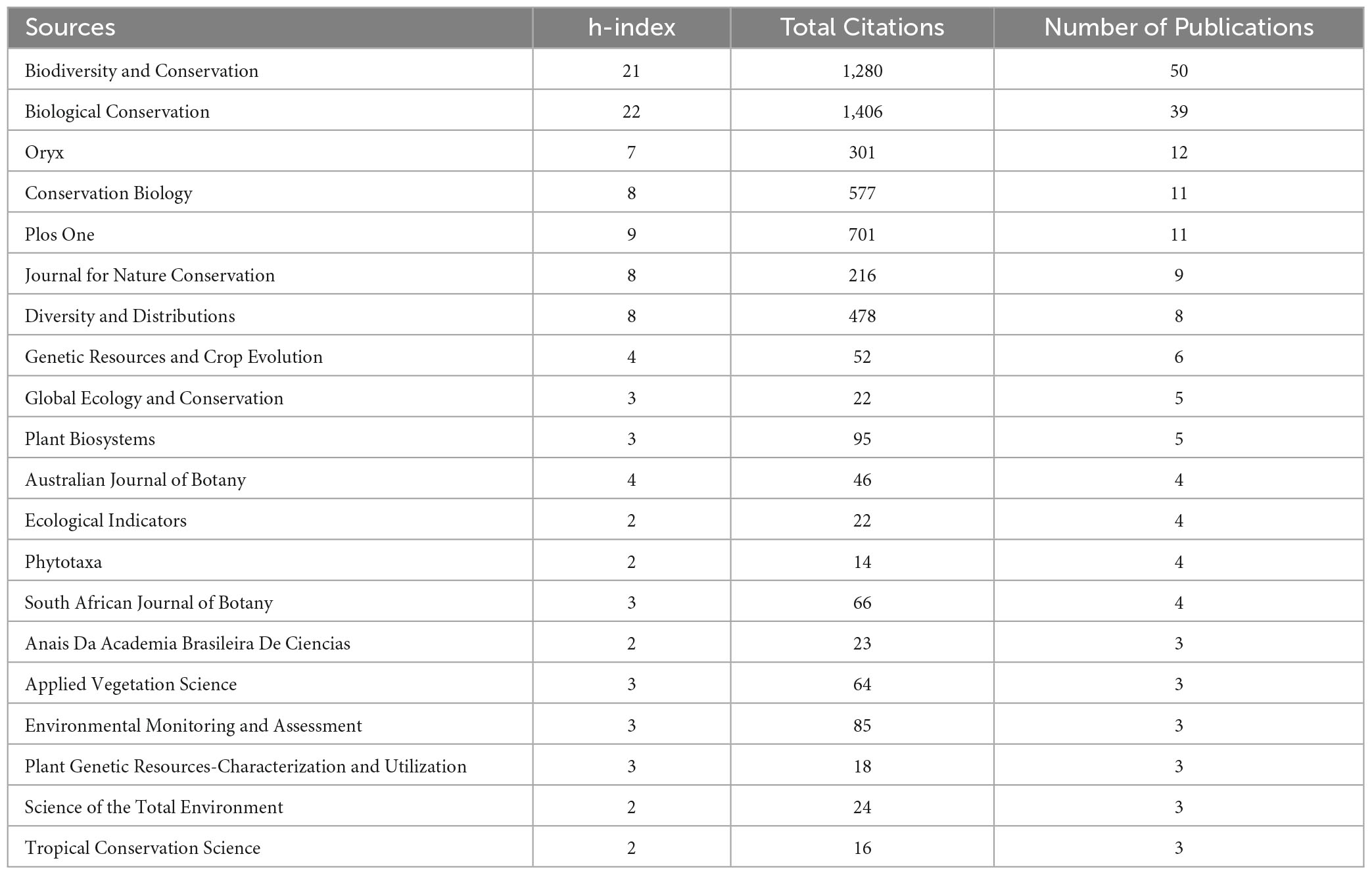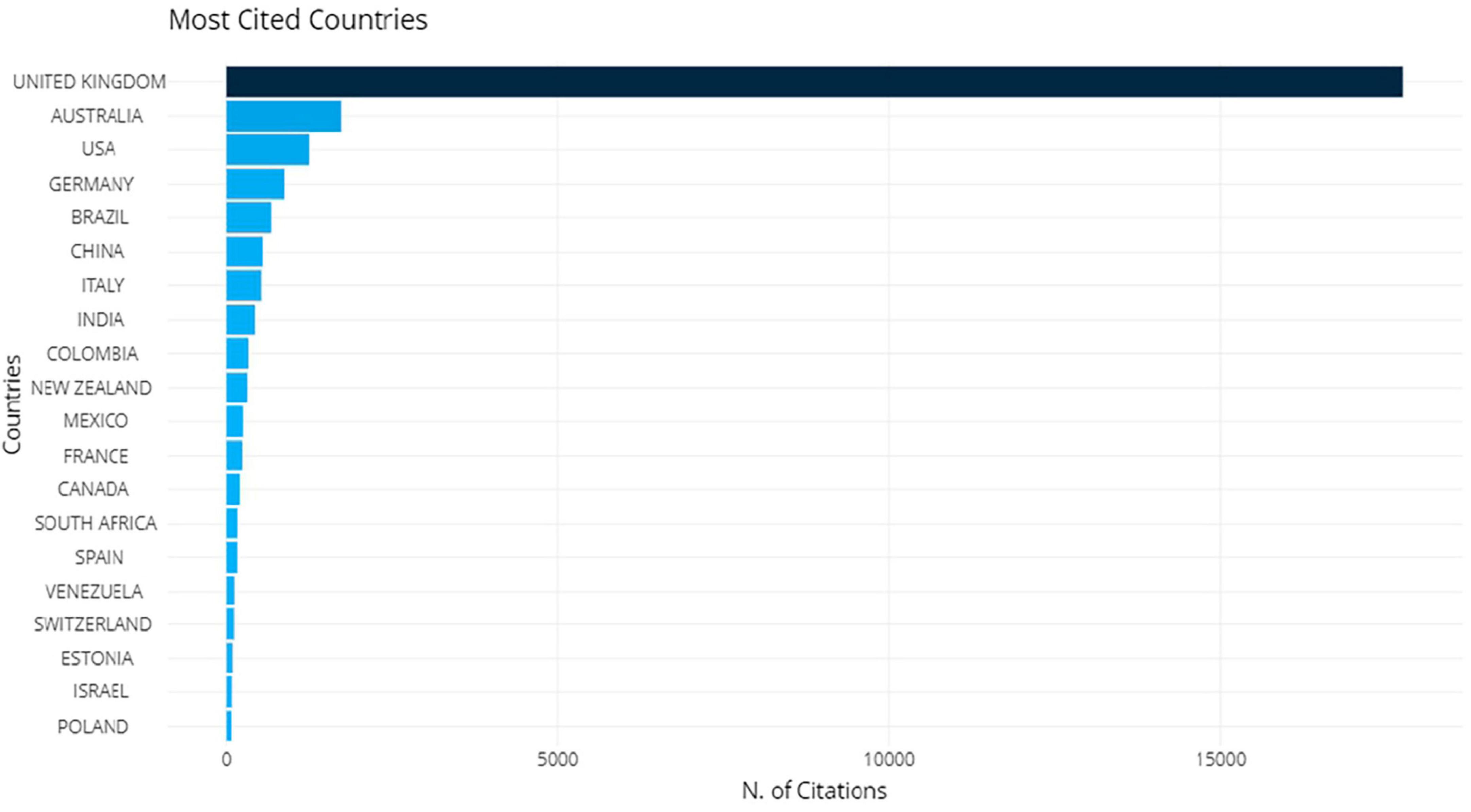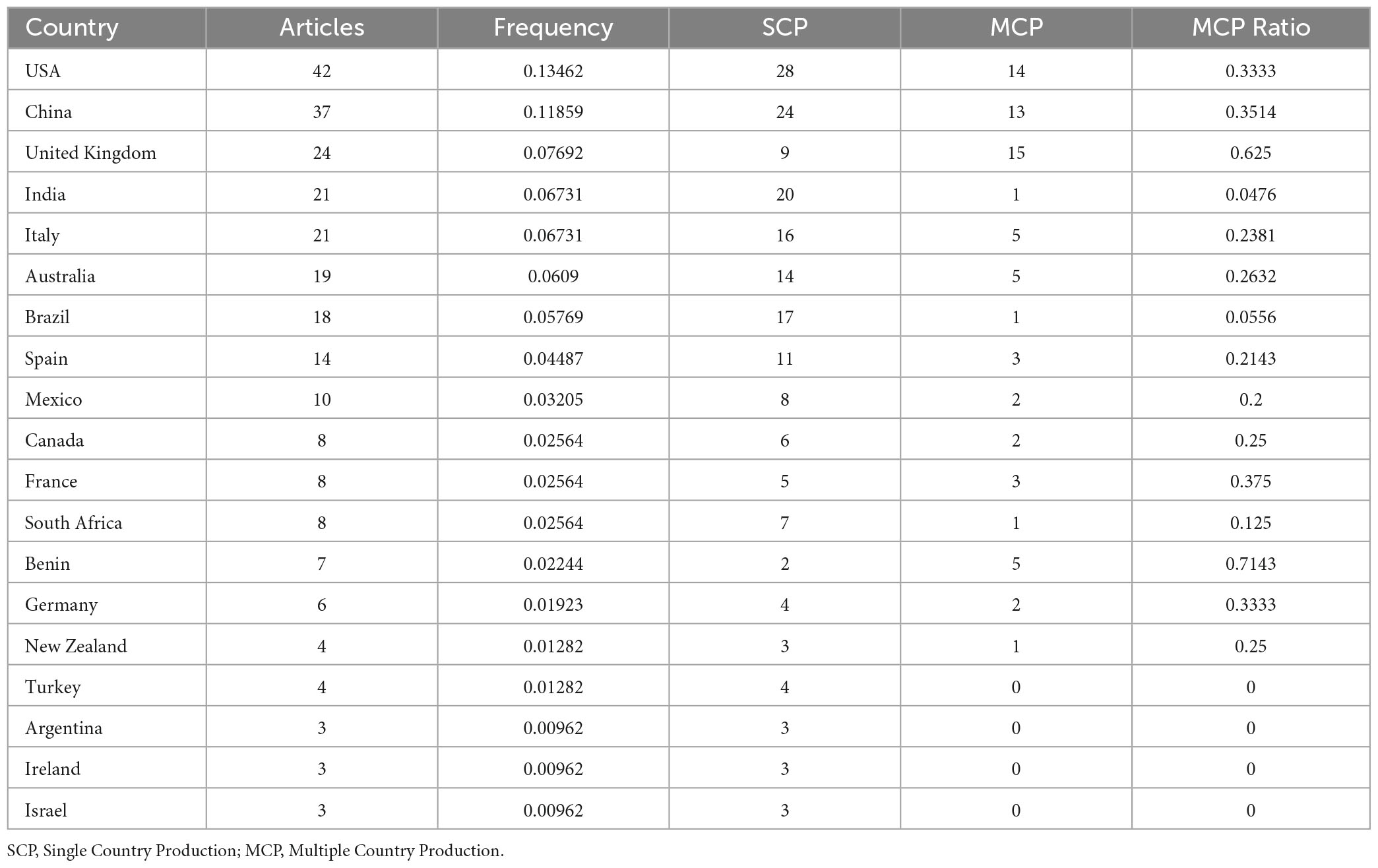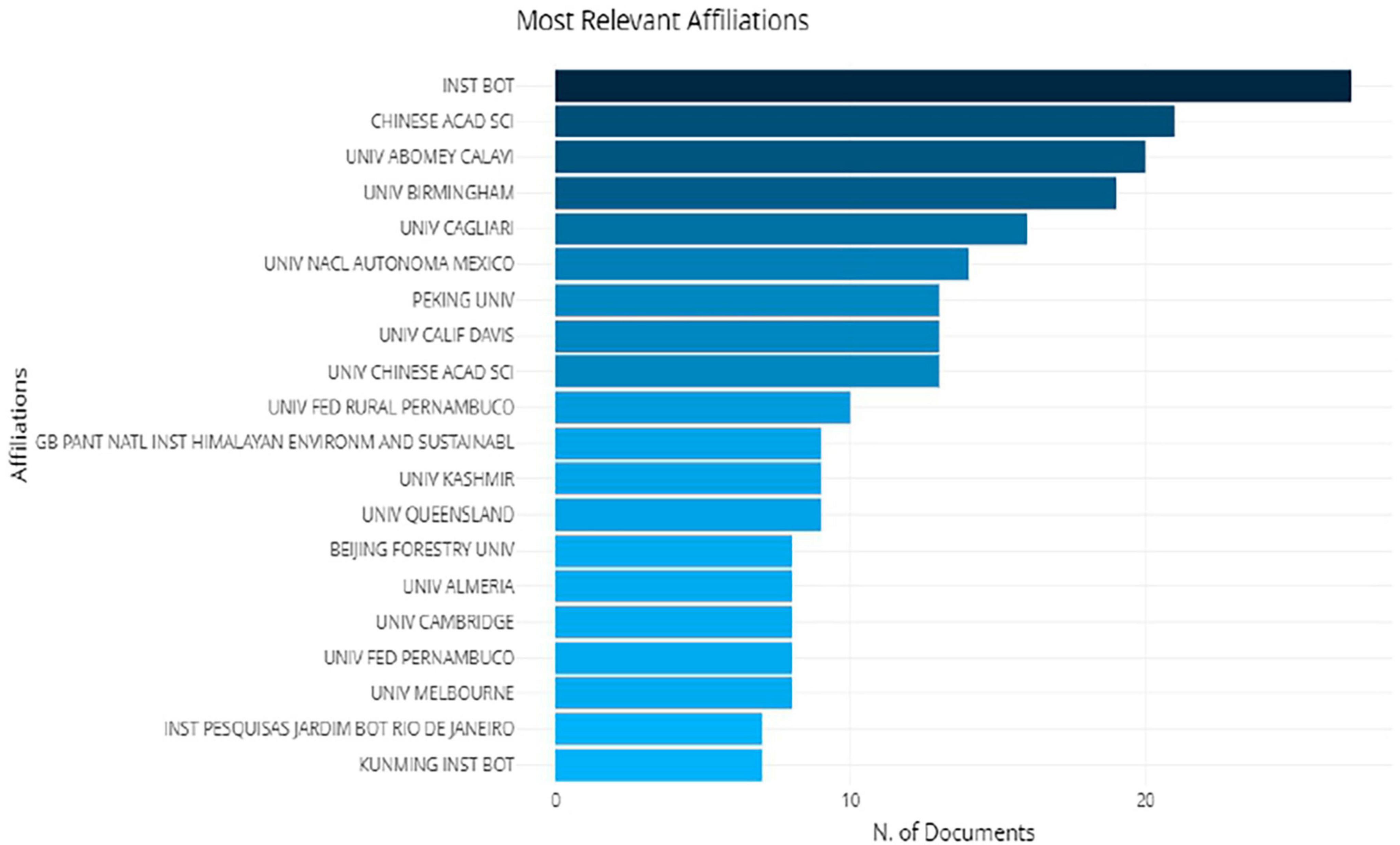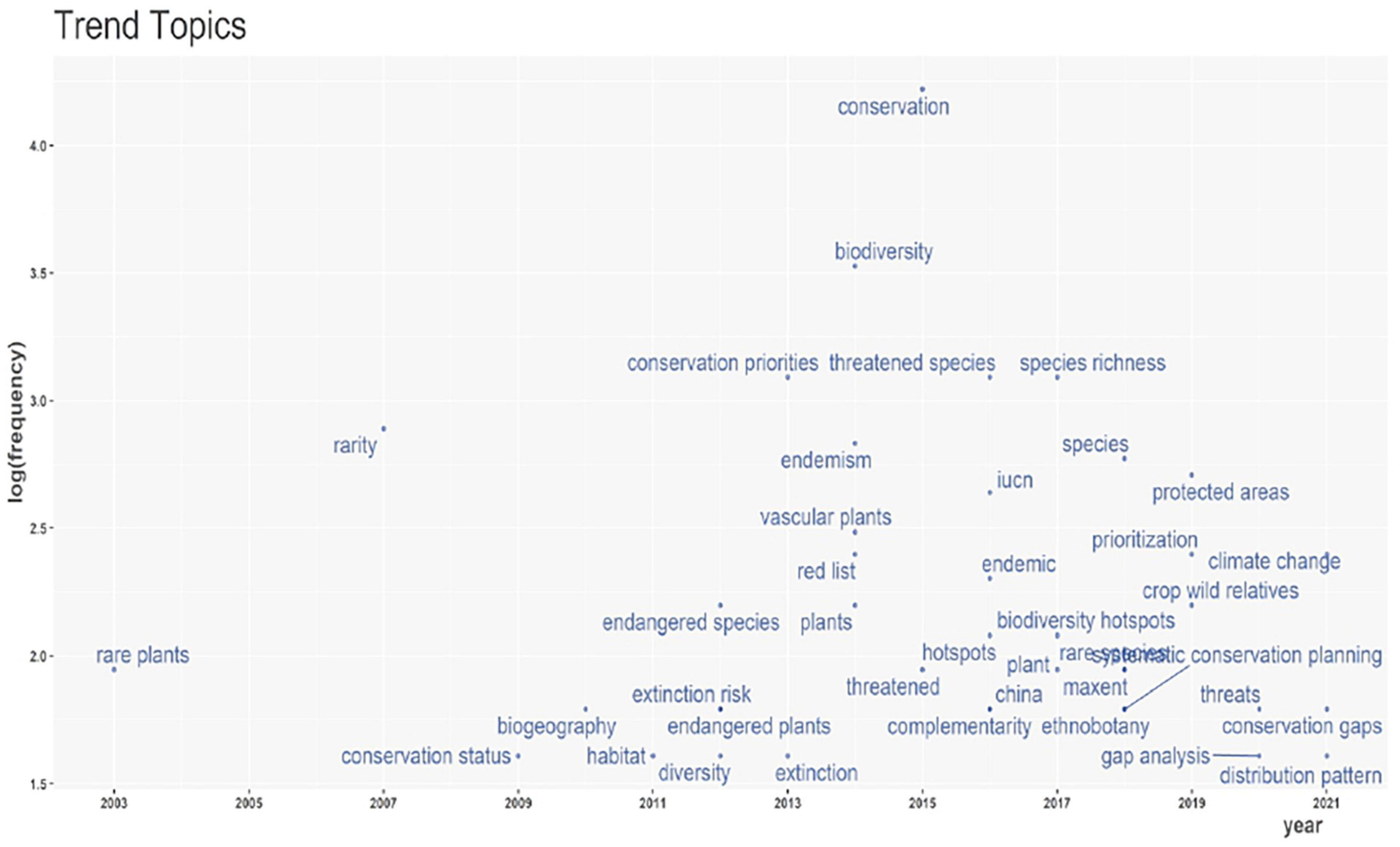- 1Conservation Ecology Lab, Department of Botany, Baba Ghulam Shah Badshah University, Rajouri, India
- 2Centre for Biodiversity Studies, Baba Ghulam Shah Badshah University, Rajouri, India
- 3Piramal Foundation for Education Leadership (State Transformation Program), Jammu and Kashmir, India
- 4Department of Life Sciences, Parul Institute of Applied Sciences, Parul University, Vadodara, Gujarat, India
- 5Department of Biology, College of Science, King Khalid University, Abha, Saudi Arabia
The present study investigated the evolution and current situation of research on threat assessment and prioritization of species for conservation at a global level by analyzing bibliometrically the most relevant and productive authors, sources, and countries, most cited papers, country collaborations and most frequent keywords as reflected in the scientific literature using the Web of Science database. From 1989–2022, a total of 315 relevant documents were retrieved from 129 sources. Results revealed that since 1989, there has been an increase in the number of publications on threat assessment and prioritization of species for conservation. A total of 1,300 authors have contributed to the field through their research contributions. Among the 129 sources, the journals ‘Biodiversity and Conservation’ and ‘Biological Conservation’ are the most relevant and productive. Among countries, the USA has produced the highest number of publications, whereas Benin has the highest Multiple Country Production with a rate of 71.4%. Among the authors, ‘Keith DA’ has received the most citations, and among the sources, the journal ‘Biological Conservation’ received the highest number of citations. Conservation, biodiversity, conservation priorities, species richness, and threatened species are the most frequently used keywords and follow power-law distribution. The present study will be useful to the researchers in determining which journals to target and how to identify potential research partners in the concerned field. It is recommended that institutions in developed countries be encouraged to lead research programs in developing and underdeveloped countries so that such studies will be carried out at local, regional, and global scale, as biodiversity loss is a global issue.
Introduction
Detailed information on different parameters of biodiversity is vital for ecological stability and balance (Mehta et al., 2020; Wani and Pant, 2023). However, biodiversity at a global level has been undergoing a critical phase owing to various drivers threatening the survival of species (Tilman et al., 2017; Ripple et al., 2019; Nic Lughadha et al., 2020; Pouteau et al., 2022). A driver is any natural or anthropogenic factor that directly or indirectly causes an alteration in an ecosystem and may threaten biodiversity by increasing extinction probabilities (Chase et al., 2020; Ngodhe, 2021). A direct driver has an unambiguous impact on ecosystem processes, while an indirect driver has a more diffused impact by fluctuating one or more direct drivers (Branquinho et al., 2019). The primary goal of the Convention on Biological Diversity (CBD) and the United Nations Sustainable Development Goals (UNSDGs) is to reduce or control global biodiversity loss and increasing species extinctions; however, success to date has been considerably inadequate (Dad and Rashid, 2022). During the 20th century, the earth lost 50% of its wetlands and 40% of its forests, and around 60% of global ecosystem services were halted (Mehta et al., 2020), with a loss of 137 species per day during the later decades of the century (Moram et al., 2011). Species extinction at such a rapid rate is considered 1,000–10,000 times than the natural extinctions in the past (Hilton-Taylor, 2000). Thus, understanding the distribution and composition of species assemblages and their prediction in space and time are extremely imperative errands to look into the providence of biodiversity from the perspective of current global change (Bhat et al., 2020; Rawat et al., 2021; Thakur et al., 2021). In order to develop efficient conservation and management plans for these biodiversity-rich areas, extensive information on species, communities, and habitats is required. Taking note of the biodiversity loss, there is an increasing array of regional, national, and international awareness and policy mechanisms aimed at the conservation of biodiversity globally (Kullberg and Moilanen, 2014).
A well-established method for identify areas with underrepresented biodiversity and taking cost-effectiveness into account when making conservation plans is systematic conservation prioritization (Karimi et al., 2023). Prioritization of species, habitats, and communities for conservation is pre-requisite for biodiversity conservation and management planning at the local, regional, and global scales (Singh and Samant, 2010). The conservation status of taxonomic units must be evaluated locally using the IUCN criteria in an appropriate manner (Rodrigues et al., 2006; Miller et al., 2007; Abeli et al., 2009). Broad, ecosystem-based conservation techniques are also necessary to stop the extinction of species; these strategies don’t rely on taxonomic data or identifying specific species, but rather on the composition of local communities and the types of habitats they occupy. When determining where to focus their efforts, organizations working to protect biodiversity are forced to make tough trade-offs (Sinclair et al., 2018). Although experts can offer valuable advice to decision makers, their capacity to handle intricate spatial optimization issues is limited (Martin et al., 2012). Prioritization has therefore been developed to deal with this issue. According to Kukkala and Moilanen (2013), prioritization is the “biogeographic-economic activity of identifying important areas for biodiversity; where, when and how we might efficiently achieve conservation goals.” Developing a Conservation Priority Index of unique species, communities, and habitats at local, regional, national, and global levels is a crucial step in planning conservation and management strategies (Wani et al., 2022). Over the past 20 years, spatial prioritizations have aided in the decision-making process regarding land use, forest planning, and conservation (Karimi et al., 2023). Global spatial conservation prioritizations have been carried out with great effort, offering comprehensive insights for global protection in the future. However, nations must decide which species to target for conservation and what national priorities should be set for expanding protected areas if they are to make significant progress toward accomplishing sustainable development goals. However, lack of sufficient funding and rapid biodiversity loss make such programs difficult for the researchers especially in the developing and underdeveloped countries. Thus, such nations should be the hotspots for these studies and sufficient funding should be allocated to these countries. Further, researchers in such countries should identify possible collaborator institutions and countries for their research projects on biodiversity conservation.
Bibliometric analysis studies have played a significant role in science and technology management and decision-making (Aleixandre-Benavent et al., 2018). Such studies are receiving considerable attention, as they provide valuable information on scientific research and its progression in a specific field of study (Aleixandre-Benavent et al., 2018). Several papers have been published employing bibliometric analysis techniques to evaluate a particular subject area or topic of research at qualitative and quantitative level: Tsunami research (Chiu and Ho, 2007; Jain et al., 2021; Suprapto et al., 2022); water research (Wang et al., 2010); biotechnology (Dalpe, 2002; Vain, 2007), deforestation (Aleixandre-Benavent et al., 2018); biodiversity loss (Tan et al., 2022); renewable energy (Rosokhata et al., 2021); ecotourism (Liu and Li, 2020; Khanra et al., 2021); climate change (Wang et al., 2014; Rana, 2020; Fu and Waltman, 2022); and COVID-19 research (Chahrour et al., 2020; Wang and Tian, 2021). In this paper, we perform a bibliometric analysis of published literature on threat assessment and prioritization of plants for conservation for the time period 1989–2022. Present study will add a new perspective to the current status and may help to identify hot spots in the field of global biodiversity conservation. More specifically, the article aims to identify the most relevant and productive sources, authors, institutions and countries, most cited authors, sources, institutions and countries, most influential articles, country collaborations and most frequently used keywords along with their growth trends from 1989–2022 in publications on threat assessment and prioritization for conservation. Present study will be useful to the researchers in determining which journals to target and how to identify potential research partners in the concerned field. Further, it will help researchers, managers, agencies and conservationists for planning better strategies to conserve and manage biodiversity.
Materials and methods
Bibliometrics is a quantitative method characterized by applying statistics and econometrics that draw on publication and citation data to determine the evolutionary structure of a research topic or field (Baker et al., 2020). It not only provides a more reliable analysis but has the potential to launch a systematic, apparent, and reproducible appraisal process based on the statistical measurement of science, scientists, or scientific activity (Aria and Cuccurullo, 2017). Many online bibliographic databases, like Web of Science, Scopus, Google Scholar, and Science Direct, where metadata concerning scientific works is stocked can be sources of bibliographic information (Cobo et al., 2011). For retrieving the relevant literature in the present study, a search was made from the Web of Science (WoS) database by using the keywords, ‘Plant threat assessment’ OR ‘Conservation prioritization’ OR ‘Conservation priority’. The database WoS was preferred as it is the most authentic and popular database among academicians (Gulhan and Kurutkan, 2021). Our initial search generated a total of 6,057 documents including research papers, reviews, editorial, letters, and proceedings. 12 review articles, 5 proceedings and 3 editorials were excluded and the remaining documents were screened through titles and abstracts to find out their suitability for our study. As, the main focus of our study was to identify such studies in which species/habitats or communities have been prioritized for conservation, a total of 315 articles formed our final dataset and information of only such papers was retrieved in bibtex format. For carrying out the bibliometric analysis of retrieved published literature on threat assessment and prioritization of plants for conservation, ‘bibliometrix’ tool developed through the R programming language was used (Ingale and Paluri, 2020; Zhang et al., 2021; Majiwala and Kant, 2022). It is a state-of-the-art tool that follows the classical bibliometric workflow (Aria and Cuccurullo, 2017). Data was analyzed for the most relevant and productive sources based on number of articles published within a source, authors, affiliations, and countries; top cited articles, authors, sources, and countries; countries collaborations; keyword analysis; and source and keyword growth trends.
Results and discussions
Publication output
From 1989–2022, a total of 6,057 documents were generated in initial search for the keywords, out of which 315 relevant documents were selected after screening of titles and abstracts. The selected scholarly documents were retrieved from 129 sources in the web of science database. A total of 14,285 references have been used in these documents. Since 1989, there has been an increase in the number of publications, from a minimum (01) publication in 1989 to a maximum (24) publication in 2019 and 2021 (Figure 1). This may be due to the fact that researchers and policy-makers have understood that there is a need for more reasonable proactive tactics, seeking to categorize and protect at-risk species in a timely manner (Walls, 2018; Le Breton et al., 2019). Still, the enormous species yet to be assessed for extinction risk, coupled with the limited resource availability for such works, necessitates rapid appraisals as a primary step toward recognizing which species, habitats, communities, and areas should be prioritized for conservation. Thus, an approach that identifies at-risk species on the basis of threshold elements of IUCN Red List criteria has the potential to amplify the speed of species prioritization for conservation (Le Breton et al., 2019). However, prioritization is incomplete without consideration of the conservation actions required to conserve the assets at particular locations (Wilson et al., 2009).
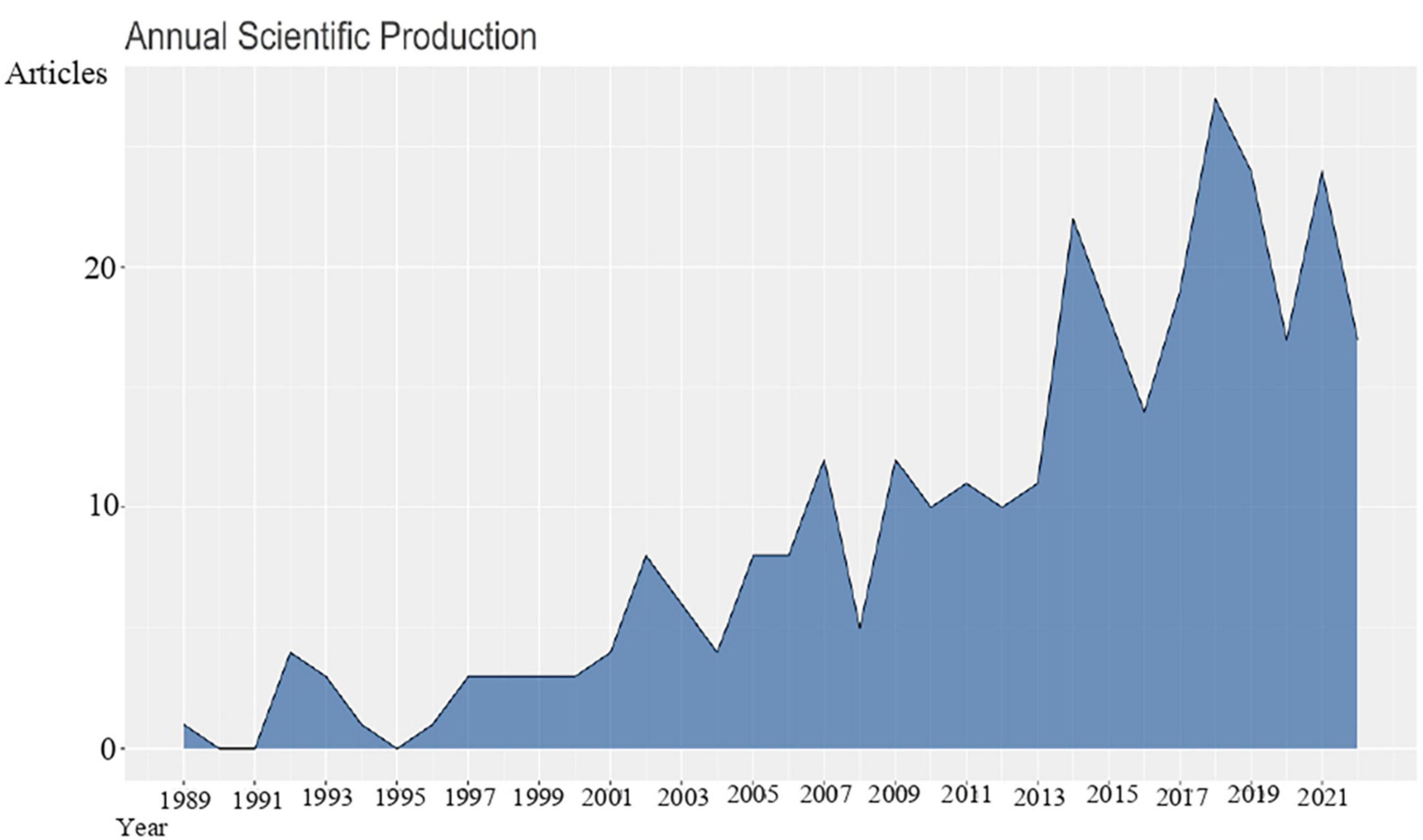
Figure 1. Annual scientific production of articles on prioritization for conservation from 1989–2022.
Most productive authors, sources, countries, and institutions
Most productive authors, countries, and institutions are the chief indicators in the bibliometric studies that emphasize leading contributors within a particular research topic or field (Sharma et al., 2020). It helps scholars and practitioners looking for collaboration and higher studies in relevant fields (Singh et al., 2021). The present study reveals that a total of 1,300 authors have contributed to the targeted research field through their research contributions. Out of these, 28 have contributed to single-authored documents and 1,272 to multi-authored documents. ‘Maxted N’ from the University of Birmingham, UK has produced the maximum number of publications (12), followed by ‘Bacchetta G’ from the University of Cagliari, Italy (08 publications), and ‘Fenu G’ from the Italian Botanical Society Onlus, Italy (07 publications) (Table 1). On examining articles and authors within the framework of Lotka Law, it is revealed that 88.3% authors contributed with a single publication, 8% with 2 publications, 2.5% with 3 publications and only 1.1% authors with more than 3 publications (Table 2). Lotka’s Law is a power-law distribution that describes the relationship between the number of authors and number of articles published by them (Lotka, 1926). It implies that few authors, (known as core authors) bear responsibility for most of the published articles, while the majority of authors only publish a small number of articles (Ridwan et al., 2023).
Of the 129 sources, the journal ‘Biodiversity and Conservation’ has been the most relevant and productive with 50 publications, followed by ‘Biological Conservation’ (39 publications), ‘Oryx’ (12 publications), ‘Conservation Biology’ and ‘Plos One’ (11 publications each), ‘Journal for Nature Conservation’ (9 publications), and ‘Diversity and Distributions’ (8 publications) (Figure 2). Based on Bradford’s law, of the total 129 sources, only four were found to be the core sources (Figure 3). Bradford’s law is a bibliometric principle that describes the relationship between journals and the articles published on a specific topic. It states that a small group of journals (known as core sources) contain a significant proportion of the articles related to a particular topic (Ridwan et al., 2023). Journals, Biodiversity and Conservation, Biological Conservation, Oryx, and Conservation Biology have been identified as the most important and basic sources for studies on threat assessments and conservation prioritization. These journals have published most number of articles on prioritization of conservation and thus are considered core journals for the topic. ‘Biodiversity and Conservation’ is an international journal that publishes articles on all aspects of biological diversity, its conservation, and sustainable use. On the other hand, ‘Biological Conservation’ is a leading international journal in the discipline of conservation science, publishing articles that contribute to the biological, sociological, ethical, and economic dimensions of conservation. Its primary aim is to publish high-quality papers that advance the science and practice of conservation or demonstrate the application of conservation principles and policy. Although the source dynamics analysis revealed that the journal ‘Biodiversity and Conservation’ remained the most relevant in terms of publications on threat assessments and prioritization for conservation up to the year 2013. But, since 2013, the number of relevant publications in ‘Biodiversity and Conservation’ has constantly decreased, and on the other hand, the number of relevant publications has increased in ‘Biological Conservation’ (Figure 4).
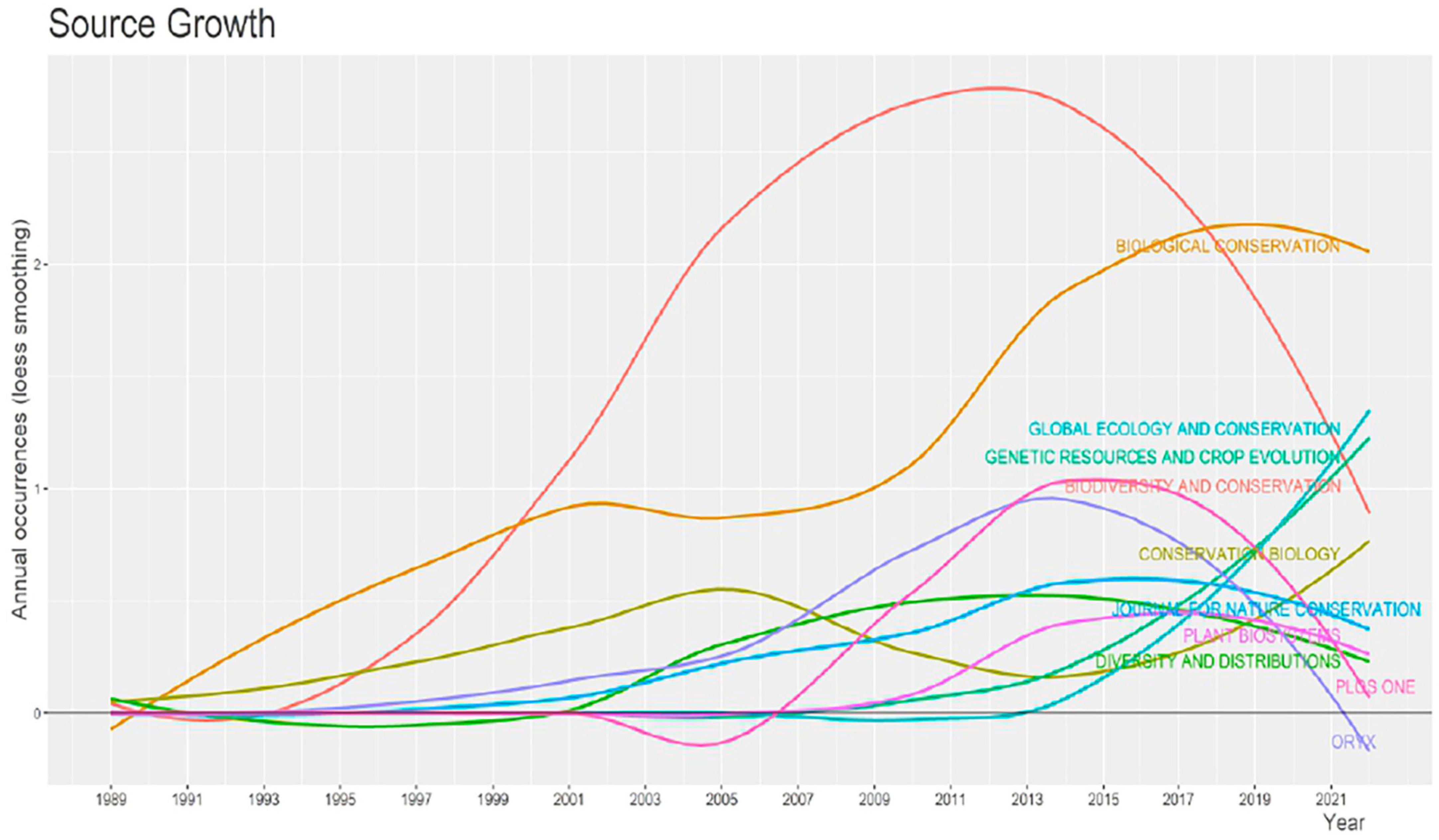
Figure 4. Growth of journals with respect to publications on prioritization for conservation from 1989–2022.
Most of the global biodiversity loss is concentrated in nine countries, viz., Australia, Brazil, China, Colombia, Ecuador, Indonesia, Malaysia, Mexico, and the USA (Mendoza-Ponce et al., 2020). This highlights the necessity for these nations to implement effective monitoring and policy enforcement for species conservation (Alroy, 2017). The present study reveals that most of these countries are working to implement effective monitoring and management policies for biodiversity conservation. Based on the country production analysis, it was revealed that authors from 76 countries have contributed to the field. The USA has the highest frequency of publications on threat assessment and prioritization for conservation (212 publications), followed by China (165 publications), the UK (106 publications), Italy (101 publications), India (79 publications), Australia (76 publications), Brazil (66 publications), Germany (46 publications), and Spain (44 publications) (Figure 5). In Himalayan Biodiversity Hotspot, China and India are the only countries to produce a significant number of publications in the relevant field. Other Himalayan countries like Pakistan and Nepal have produced 04 and 03 publications, respectively; whereas Bhutan has not produced any publication in the relevant field.
Citation analysis
Citation analysis is a fundamental method for science mapping that works on the conjecture that citations reflect intellectual linkages between publications that are formed when one document cites the other (Appio et al., 2014). The analysis enables the most influential publications in a research field to be determined (Donthu et al., 2021). In the present study, on average, each document has received 84.68 citations, with 5.50 citations per year per document. The most global cited document on threat assessment and prioritization for conservation include Schnittler and Gunther, 1999; Dhar et al., 2000; Myers et al., 2000; Coates and Atkins, 2001; Hartley and Kunin, 2003; Kala et al., 2004; Keller and Bollmann, 2004; Partel et al., 2005; de Oliveira et al., 2007; Zhang and Ma, 2008; Brehm et al., 2010; Gauthier et al., 2010; Bacchetta et al., 2012; Brummitt et al., 2015. Among the authors, ‘Keith DA’ from the New South Wales National Parks and Wildlife Service, Australia has received the maximum impact with 439 citations and h-index of 3 (Number of publications = 4), followed by ‘Maxted N’ from the University of Birmingham, UK with 428 citations and 7 h-index (Number of publications = 12), ‘Burgman MA’ from the University of Melbourne, Australia with 376 citations and 3 h-index (Number of publications = 3), and ‘Bacchetta G’ from the University of Cagliari, Italy with 328 citations and 7 h-index (Number of publications = 8) (Table 1). Among the sources, the journal Biological Conservation tops the list with highest number of citations (1,406 citations; 22 h-index), followed by Biodiversity and Conservation (1,280 citations; 21 h-index), Plos One (701 citations; 9 h-index), Conservation Biology (577 citations; 8 h-index), and Diversity and Distribution (478 citations; 8 h-index) (Table 3). The h-index calculates an author’s number of publications and citations for those articles (Kumar et al., 2023). It gives a breakthrough in the research community for assessing the scientific impact of an individual or source (Bihari et al., 2023). Among the most cited countries, the UK ranks at the top with 17,753 citations, followed by Australia, the USA, Germany, Brazil, China, Italy and India with 1,738, 1,242, 882, 683, 561, 540, and 444 citations, respectively (Figure 6).
Collaboration analysis
Collaboration analysis is another important science mapping procedure to reveal how contributors are linked to each other in a particular research field. It determines the pertinent contributors and their relationships (Aria and Cuccurullo, 2020). Of the total 315 documents, 28 are single-authored documents, and the average number of documents per author is 0.242. The average number of authors and co-authors per document is 4.13 and 4.86, respectively, with a collaboration index of 4.43. Countries with a Multiple Country Publications (MCP) rate ≥ 50% are the countries with high international cooperation in the field (Gulhan and Kurutkan, 2021). In the present study, Benin has the highest MCP with a rate of 71.4%, followed by the UK (62.5%) and France (37.5%). India has an MCP rate of only 4.76% (Table 4). Figure 7 depicts the country collaboration in threat assessment and prioritization for conservation studies, in which the blue color indicates the countries that have published the articles, and its intensity is proportional to the number of publications. The pink color line represents the connection between the countries, and its thickness depicts the level of collaboration. Collaboration is essential for conservation (Lloyd et al., 2023), as it will allow successful implementation of biodiversity conservation programs throughout the globe. Based on the most contributing institutes, the Institute of Botany has produced the maximum number of documents (27 publications), followed by the Chinese Academy of Sciences (21 publications), the University of Abomey-Calavi (20 publications), the University of Birmingham (19 publications), and the University of Cagliari (16 publications). Figure 8 shows the top twenty relevant affiliations of the corresponding authors with Institute of Botany, China, Chinese Academy of Sciences, China, University of Abomey-Calavi, Benin, and University of Birmingham, England as the most relevant affiliations.
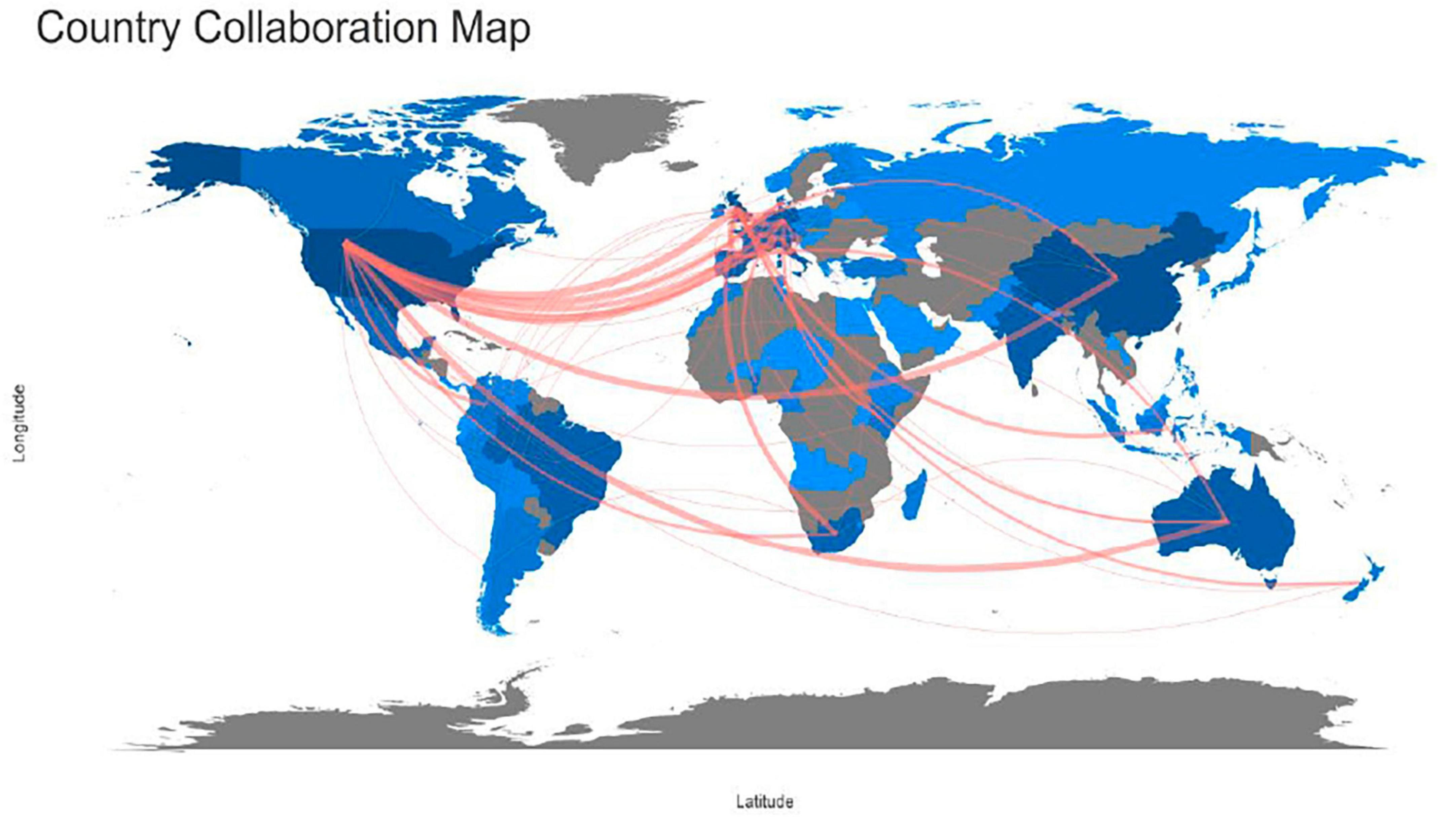
Figure 7. Country collaboration map (Intensity of blue color shows number of publications and the pink line depicts the connections).
Keywords analysis
Author keywords identify the content and theme of the published document (Sharma et al., 2020). For each article dealing with the threat assessment and prioritization for conservation, the original author keywords, i.e., used by the authors in the articles, were examined. A total of 1,008 keywords have been used by the authors to classify their studies from 1989–2022. Figure 9 depicts a scatter plot of the most trending topics in threat assessment and the prioritization for conservation studies from 1989–2022. The height of keywords shows their frequency of occurrence in a particular year. The most frequently occurring keywords typically express the most trending topics of the year. The most frequently used keywords include conservation (68 in 2015), biodiversity (34 in 2014), conservation priorities, species richness and threatened species (22 each in 2013, 2017, and 2016, respectively), and rarity (18 in 2007). The frequency of keywords and their ranks follow a power-law distribution, with a few keywords used frequently whereas most of the keywords are not used so frequently, which is consistent with earlier studies (Li et al., 2008; Liu et al., 2011).
Limitations of the study
In the present study, data has been exclusively drawn from WoS data source, thus not representing the comprehensive literature in the field. Although, WoS is the most authentic and popular database among academicians, it is highly recommended that alternative data sources like Scopus and Google Scholar should be included in future studies for more thorough analysis of the available research documents on this topic. Besides using bibliometrix tool, analysis of data through BibExcel, CiteSpace, Hist Cite, and Pajek would be a better option for providing further detailed information on literature. Further, as in the present study, the search for data was conducted only in the English and there is a possibility that relevant publications in other languages may have been missed. By limiting the search to only English only, there is a risk of missing out some valuable findings published in other languages. Therefore, researchers should consider the possibility of including publications in other languages in future studies for more vivid and all-inclusive analysis of data. Despite of these limitations, our study provides imperative insights on research trends and directions in the conservation of biodiversity elements. By addressing these limitations in future investigations, researchers can further enhance and expand the knowledge base in this field.
Conclusion
The present study has investigated the evolution and current situation of research on threat assessment and prioritization of plants for conservation at a global level by analyzing bibliometrically the most relevant and productive authors, sources, and countries, most cited papers, country collaborations, and most frequent keyword aspects as reflected in the scientific literature. The present study will be helpful to the researchers to find out which journal should be targeted and to find out their research collaborators in the relevant field. Further, the study may be useful to identify the hotspots for further such studies. Our bibliometric analysis indicated that output in the relevant field has significantly increased since 1989. A total of 1,300 authors have contributed to 315 articles published in 129 journals. The journal Biodiversity and Conservation and Biological Conservation have produced the highest number of articles, whereas the journal Biological Conservation has received the maximum number of citations. The countries where most biodiversity loss is concentrated, like the USA, China, Australia, Brazil, and Mexico, has produced the maximum number of publications on threat assessment and prioritization for conservation. Benin, a developing country of West Africa has the highest rate of Multiple Country production indicating that both developed and developing countries are working together to tackle the global biodiversity loss. However, as GDP growth is the prime goal of most local governments in developing and underdeveloped countries institutions in developed countries should be encouraged to lead research programs in such countries. Global conservation needs far exceed any one organization’s capacity and resources. Conservationists prioritize species, resources, and actions every day, but only through a structured decision-making process can strategic decisions be made in an explicit, transparent, and effective manner. This will also facilitate potential partnerships among conservation organizations, philanthropists, and other stakeholders.
Data availability statement
The original contributions presented in this study are included in this article/supplementary material, further inquiries can be directed to the corresponding author.
Author contributions
ZW: Conceptualization, Data curation, Formal analysis, Investigation, Methodology, Writing—original draft, Writing—review and editing. SP: Supervision, Writing—review and editing. JB: Writing—review and editing. MT: Writing—review and editing. SS: Funding acquisition, Writing—review and editing. MA: Writing—review and editing.
Funding
The author(s) declare that financial support was received for the research, authorship, and/or publication of this article. The authors extend their appreciation to the Deanship of Scientific Research at King Khalid University for funding this work through a Large Group Research Project under grant number RGP2/90/44.
Conflict of interest
The authors declare that the research was conducted in the absence of any commercial or financial relationships that could be construed as a potential conflict of interest.
Publisher’s note
All claims expressed in this article are solely those of the authors and do not necessarily represent those of their affiliated organizations, or those of the publisher, the editors and the reviewers. Any product that may be evaluated in this article, or claim that may be made by its manufacturer, is not guaranteed or endorsed by the publisher.
References
Abeli, T., Gentili, R., Rossi, G., Bedini, G., and Foggi, B. (2009). Can the IUCN criteria be effectively applied to peripheral isolated plant populations? Biodiver. Conserv. 18, 3877–3890.
Aleixandre-Benavent, R., Aleixandre-Tudo, J. L., Castelló-Cogollos, L., and Aleixandre, J. L. (2018). Trends in global research in deforestation. A bibliometric analysis. Land Use Policy 72, 293–302.
Alroy, J. (2017). Effects of habitat disturbance on tropical forest biodiversity. Proc. Natl. Acad. Sci. U.S.A 114, 6056–6061.
Appio, F. P., Cesaroni, F., and Di Minin, A. (2014). Visualizing the structure and bridges of the intellectual property management and strategy literature: A document cocitation analysis. Scientometrics 101, 623–661.
Aria, M., and Cuccurullo, C. (2017). bibliometrix: An R-tool for comprehensive science mapping analysis. J. Informetrics 11, 959–975.
Aria, M., and Cuccurullo, C. (2020). Science Mapping Analysis with bibliometrix R-package: An example. Available online at: https://bibliometrix.org/documents/bibliometrix_Report.html (accessed January 16, 2023).
Bacchetta, G., Farris, E., and Pontecorvo, C. (2012). A new method to set conservation priorities in biodiversity hotspots. Plant Biosyst. Int. J. Deal. all Aspects Plant Biol. 146, 638–648. doi: 10.1002/aps3.1023
Baker, H. K., Kumar, S., and Pattnaik, D. (2020). Research constituents, intellectual structure, and collaboration pattern in the journal of forecasting: A bibliometric analysis. J. Forecast. 2020, 1–26.
Bhat, J. A., Kumar, M., Negi, A. K., Todaria, N. P., Malik, Z. A., Pala, N. A., et al. (2020). Species diversity of woody vegetation along altitudinal gradient of the Western Himalayas. Glob. Ecol. Conserv. 24, e01302.
Bihari, A., Tripathi, S., and Deepak, A. (2023). A review on h-index and its alternative indices. J. Inf. Sci. 49, 624–665.
Branquinho, C., Serrano, H. C., Nunes, A., Pinho, P., and Matos, P. (2019). Essential biodiversity change indicators for evaluating the effects of Anthropocene in ecosystems at a global scale. From assessing to conserving biodiversity. Cham: Springer, 137–163.
Brehm, J. M., Maxted, N., Martins-Loucao, M. A., and Ford-Lloyd, B. V. (2010). New approaches for establishing conservation priorities for socio-economically important plant species. Biodivers. Conserv. 19, 2715–2740.
Brummitt, N. A., Bachman, S. P., Griffiths-Lee, J., Lutz, M., Moat, J. F., Farjon, A., et al. (2015). Green plants in the red: A baseline global assessment for the IUCN sampled Red List Index for plants. PloS One 10, e0135152. doi: 10.1371/journal.pone.0135152
Chahrour, M., Assi, S., Bejjani, M., Nasrallah, A. A., Salhab, H., Fares, M., et al. (2020). A bibliometric analysis of COVID-19 research activity: a call for increased output. Cureus 12:e7357. doi: 10.7759/cureus.7357
Chase, J. M., Jeliazkov, A., Ladouceur, E., and Viana, D. S. (2020). Biodiversity conservation through the lens of metacommunity ecology. Ann. N. Y. Acad. Sci. 1469, 86–104.
Chiu, W. T., and Ho, Y. S. (2007). Bibliometric analysis of tsunami research. Scientometrics 73, 3–17.
Coates, D. J., and Atkins, K. A. (2001). Priority setting and the conservation of Western Australia’s diverse and highly endemic flora. Biol. Conserv. 97, 251–263.
Cobo, M. J., Lopez-Herrera, A. G., Herrera-Viedma, E., and Herrera, F. (2011). An approach for detecting, quantifying, and visualizing the evolution of a research field: a practical application to the fuzzy sets theory field. J. Informetrics 5, 146–166.
Dad, J. M., and Rashid, I. (2022). Differential responses of Kashmir Himalayan threatened medicinal plants to anticipated climate change. Environ. Conserv. 49, 33–41.
de Oliveira, R. L., Lins Neto, E. M., Araujo, E. L., and Albuquerque, U. P. (2007). Conservation priorities and population structure of woody medicinal plants in an area of caatinga vegetation (Pernambuco State, NE Brazil). Environ. Monitor. Assess. 132, 189–206. doi: 10.1007/s10661-006-9528-7
Dhar, U., Rawal, R. S., and Upreti, J. (2000). Setting priorities for conservation of medicinal plants—-a case study in the Indian Himalaya. Biol. Conserv. 95, 57–65.
Donthu, N., Kumar, S., Mukherjee, D., Pandey, N., and Lim, W. M. (2021). How to conduct a bibliometric analysis: An overview and guidelines. J. Bus. Res. 133, 285–296.
Fu, H. Z., and Waltman, L. (2022). A large-scale bibliometric analysis of global climate change research between 2001 and 2018. Climatic Change 170, 1–21.
Gauthier, P., Debussche, M., and Thompson, J. D. (2010). Regional priority setting for rare species based on a method combining three criteria. Biol. Conserv. 143, 1501–1509.
Gulhan, P. Y., and Kurutkan, M. N. (2021). Bibliometric analysis of covid-19 publications in the field of chest and infectious diseases. Duzce Med. J. 23, 30–40.
Hartley, S., and Kunin, W. E. (2003). Scale dependency of rarity, extinction risk, and conservation priority. Conserv. Biol. 17, 1559–1570.
Hilton-Taylor, C. (2000). The 2000 IUCN Red List of threatened species. Cambridge: World Conservation Union.
Ingale, K. K., and Paluri, R. A. (2020). Financial literacy and financial behaviour: A bibliometric analysis. Rev. Behav. Finan. [Epub ahead of print]. doi: 10.1108/rbf-06-2020-0141
Jain, N., Virmani, D., and Abraham, A. (2021). Tsunami in the last 15 years: a bibliometric analysis with a detailed overview and future directions. Natl. Hazards 106, 139–172.
Kala, C. P., Farooquee, N. A., and Dhar, U. (2004). Prioritization of medicinal plants on the basis of available knowledge, existing practices and use value status in Uttaranchal. India. Biodivers. Conserv. 13, 453–469.
Karimi, A., Yazdandad, H., and Reside, A. E. (2023). Spatial conservation prioritization for locating protected area gaps in Iran. Biol. Conserv. 279:109902.
Keller, V., and Bollmann, K. (2004). From red lists to species of conservation concern. Conserv. Biol. 18, 1636–1644.
Khanra, S., Dhir, A., Kaur, P., and Mantymaki, M. (2021). Bibliometric analysis and literature review of ecotourism: Toward sustainable development. Tour. Manage. Perspect. 37:100777.
Kukkala, A. S., and Moilanen, A. (2013). Core concepts of spatial prioritisation in systematic conservation planning. Biol. Rev. Cambridge Philos. Soc. 88, 443–464. doi: 10.1111/brv.12008
Kullberg, P., and Moilanen, A. (2014). How do recent spatial biodiversity analyses support the convention on biological diversity in the expansion of the global conservation area network? Natureza and Conservacao 12, 3–10.
Kumar, M., George, R. J., and Ps, A. (2023). Bibliometric analysis for medical research. Indian J. Psychol. Med. 45, 277–282.
Le Breton, T. D., Zimmer, H. C., Gallagher, R. V., Cox, M., Allen, S., and Auld, T. D. (2019). Using IUCN criteria to perform rapid assessments of at-risk taxa. Biodivers. Conserv. 28, 863–883.
Li, T., Ho, Y. S., and Li, C. Y. (2008). Bibliometric analysis on global Parkinson’s disease research trends during 1991–2006. Neurosci. Lett. 441, 248–252. doi: 10.1016/j.neulet.2008.06.044
Liu, S., and Li, W. Y. (2020). Ecotourism research progress: A bibliometric analysis during 1990–2016. Sage Open 10:2158244020924052.
Liu, X., Zhang, L., and Hong, S. (2011). Global biodiversity research during 1900–2009: a bibliometric analysis. Biodivers. Conserv. 20, 807–826.
Lloyd, N. A., Keating, L. M., Friesen, A. J., Cole, D. M., McPherson, J. M., Akçakaya, H. R., et al. (2023). Prioritizing species conservation programs based on IUCN Green Status and estimates of cost-sharing potential. Conserv. Biol. 2023:e14051. doi: 10.1111/cobi.14051
Lotka, A. J. (1926). The frequency distribution of scientific productivity. J. Wash. Acad. Sci. 16, 317–323.
Majiwala, H., and Kant, R. (2022). A bibliometric review of a decade’ research on industry 4.0 & supply chain management. Mater. Today [Epub ahead of print]. doi: 10.1016/j.matpr.2022.09.058
Martin, T. G., Burgman, M. A., Fidler, F., Kuhnert, P. M., Low-Choy, S., Mcbride, M., et al. (2012). Eliciting expert knowledge in conservation science. Conserv. Biol. 26, 29–38.
Mehta, P., Sekar, K. C., Bhatt, D., Tewari, A., Bisht, K., Upadhyay, S., et al. (2020). Conservation and prioritization of threatened plants in Indian Himalayan Region. Biodivers. Conserv. 29, 1723–1745. doi: 10.1007/s12298-021-01044-9
Mendoza-Ponce, A. V., Corona-Nunez, R. O., Kraxner, F., and Estrada, F. (2020). Spatial prioritization for biodiversity conservation in a megadiverse country. Anthropocene 32:100267.
Miller, R. M., Rodriguez, J. P., Aniskowicz-Fowler, T., Bambaradeniya, C., Boles, R., Eaton, M. A., et al. (2007). National threatened species listing based on IUCN criteria and regional guidelines: current status and future perspectives. Conserv. Biol. 21, 684–696. doi: 10.1111/j.1523-1739.2007.00656.x
Moram, C., Tittensor, D. P., Adl, S., Simpson, A. G. B., and Worm, B. (2011). How many species are there on earth and in the ocean? PLoS Biol. 9, 1100–1127.
Myers, N., Mittermeier, R. A., Mittermeier, C. G., Da Fonseca, G. A., and Kent, J. (2000). Biodiversity hotspots for conservation priorities. Nature 403, 853–858.
Ngodhe, S. O. (2021). A review on Causes of Ecological change along Lake Victoria basin, Kenya. Sci. Rep. Life Sci. 2, 30–39.
Nic Lughadha, E., Bachman, S. P., Leao, T. C., Forest, F., Halley, J. M., Moat, J., et al. (2020). Extinction risk and threats to plants and fungi. Plants People Planet 2, 389–408.
Partel, M., Kalamees, R., Reier, U., Tuvi, E. L., Roosaluste, E., Vellak, A., et al. (2005). Grouping and prioritization of vascular plant species for conservation: combining natural rarity and management need. Biol. Conserv. 123, 271–278.
Pouteau, R., Brunel, C., Dawson, W., Essl, F., Kreft, H., Lenzner, B., et al. (2022). Environmental and socioeconomic correlates of extinction risk in endemic species. Divers. Distrib. 28, 53–64. doi: 10.1093/aobpla/plaa007
Rana, I. A. (2020). Disaster and climate change resilience: A bibliometric analysis. Int. J. Disas. Risk Red. 50:101839.
Rawat, B., Gaira, K. S., Gairola, S., Tewari, L. M., and Rawal, R. S. (2021). Spatial prediction of plant species richness and density in high-altitude forests of Indian west Himalaya. Trees Forests People 6:100132.
Ridwan, Q., Wani, Z. A., Anjum, N., Bhat, J. A., Hanief, M., and Pant, S. (2023). Human-wildlife conflict: A bibliometric analysis during 1991–2023. Reg. Sustain. 4, 309–321.
Ripple, W. J., Wolf, C., Newsome, T. M., Betts, M. G., Ceballos, G., Courchamp, F., et al. (2019). Are we eating the world’s megafauna to extinction? Conserv. Lett. 12, e12627.
Rodrigues, A. S., Pilgrim, J. D., Lamoreux, J. F., Hoffmann, M., and Brooks, T. M. (2006). The value of the IUCN Red List for conservation. Trends Ecol. Evol. 21, 71–76.
Rosokhata, A., Minchenko, M., Khomenko, L., and Chygryn, O. (2021). Renewable energy: A bibliometric analysis. E3S Web Conf. 250:03002.
Schnittler, M., and Gunther, K. F. (1999). Central European vascular plants requiring priority conservation measures–an analysis from national Red Lists and distribution maps. Biodivers. Conserv. 8, 891–925.
Sharma, P., Singh, R., Tamang, M., Singh, A. K., and Singh, A. K. (2020). Journal of teaching in travel &tourism: a bibliometric analysis. J. Teach. Travel Tour. [Epub ahead of print]. doi: 10.1080/15313220.2020.1845283
Sinclair, S. P., Milner-Gulland, E. J., Smith, R. J., McIntosh, E. J., Possingham, H. P., Vercammen, A., et al. (2018). The use, and usefulness, of spatial conservation prioritizations. Conserv. Lett. 11, e12459.
Singh, A., and Samant, S. S. (2010). Conservation prioritization of habitats and forest communities in the Lahaul Valley of proposed cold desert biosphere reserve, north western Himalaya, India. Appl. Ecol. Environ. Res. 8, 101–117.
Singh, R., Sibi, P. S., and Sharma, P. (2021). Journal of ecotourism: a bibliometric analysis. J. Ecotour. [Epub ahead of print] doi: 10.1080/14724049.2021.1916509
Suprapto, N., Yanti, V. K., and Hariyono, E. (2022). Global research on tsunami education and tsunami mitigation: A bibliometric analysis. Sci. Tsunami Hazards 41, 130–146.
Tan, Y. L., Yiew, T. H., Habibullah, M. S., Chen, J. E., Mat Kamal, S. N. I., and Saud, N. A. (2022). Research trends in biodiversity loss: a bibliometric analysis. Environ. Sci. Pollut. Res. 30, 1–17. doi: 10.1007/s11356-022-22211-9
Thakur, U., Bisht, N. S., Kumar, M., and Kumar, A. (2021). Influence of altitude on diversity and distribution pattern of trees in Himalayan temperate forests of Churdhar Wildlife Sanctuary, India. Water Air Soil Pollut. 232:205.
Tilman, D., Clark, M., Williams, D. R., Kimmel, K., Polasky, S., and Packer, C. (2017). Future threats to biodiversity and pathways to their prevention. Nature 546, 73–81.
Vain, P. (2007). Trends in GM crop, food and feed safety literature. Nat. Biotechnol. 25, 624–626. doi: 10.1038/nbt0607-624b
Walls, S. C. (2018). Coping with constraints: achieving effective conservation with limited resources. Front. Ecol. Evol. 6:24. doi: 10.3389/fevo.2018.00024
Wang, B., Pan, S. Y., Ke, R. Y., Wang, K., and Wei, Y. M. (2014). An overview of climate change vulnerability: a bibliometric analysis based on Web of Science database. Natl. Hazards 74, 1649–1666. doi: 10.1007/s11356-021-17995-1
Wang, M. H., Yu, T. C., and Ho, Y. S. (2010). A bibliometric analysis of the performance of Water Research. Scientometrics 84, 813–820.
Wang, P., and Tian, D. (2021). Bibliometric analysis of global scientific research on COVID-19. J. Biosafety Biosecur. 3, 4–9.
Wani, Z. A., Bhat, J. A., Negi, V. S., Satish, K. V., Siddiqui, S., and Pant, S. (2022). Conservation Priority Index of species, communities, and habitats for biodiversity conservation and their management planning: A case study in Gulmarg Wildlife Sanctuary, Kashmir Himalaya. Front. For. Glob. Change 6:1225330. doi: 10.3389/ffgc.2023.1225330
Wani, Z. A., and Pant, S. (2023). Status of Biodiversity in a Protected Area of Kashmir Himalaya: Gulmarg Wildlife Sanctuary. Nordic J. Bot. 2023:e03982.
Wilson, K. A., Carwardine, J., and Possingham, H. P. (2009). Setting conservation priorities. Ann. N. Y. Acad. Sci. 1162, 237–264.
Zhang, J. Z., Srivastava, P. R., Sharma, D., and Eachempati, P. (2021). Big data analytics and machine learning: A retrospective overview and bibliometric analysis. Expert Syst. Applic. 184:115561.
Keywords: bibliometric, threat assessment, prioritization, conservation, biological conservation
Citation: Wani ZA, Pant S, Bhat JA, Tariq M, Siddiqui S and Alshaharni MO (2024) Bibliometric analysis of studies on threat assessment and prioritization of species for conservation. Front. For. Glob. Change 7:1374120. doi: 10.3389/ffgc.2024.1374120
Received: 21 January 2024; Accepted: 19 February 2024;
Published: 07 March 2024.
Edited by:
Gopal Shukla, Uttar Banga Krishi Viswavidyalaya, IndiaReviewed by:
Amit Kumar, Nanjing University of Information Science and Technology, ChinaMuhammad Waheed, University of Okara, Pakistan
Copyright © 2024 Wani, Pant, Bhat, Tariq, Siddiqui and Alshaharni. This is an open-access article distributed under the terms of the Creative Commons Attribution License (CC BY). The use, distribution or reproduction in other forums is permitted, provided the original author(s) and the copyright owner(s) are credited and that the original publication in this journal is cited, in accordance with accepted academic practice. No use, distribution or reproduction is permitted which does not comply with these terms.
*Correspondence: Zishan Ahmad Wani, emlzaGFud2FuaTc4NkBnbWFpbC5jb20=
 Zishan Ahmad Wani
Zishan Ahmad Wani Shreekar Pant
Shreekar Pant Jahangeer A. Bhat
Jahangeer A. Bhat Mohd Tariq4
Mohd Tariq4 Sazada Siddiqui
Sazada Siddiqui